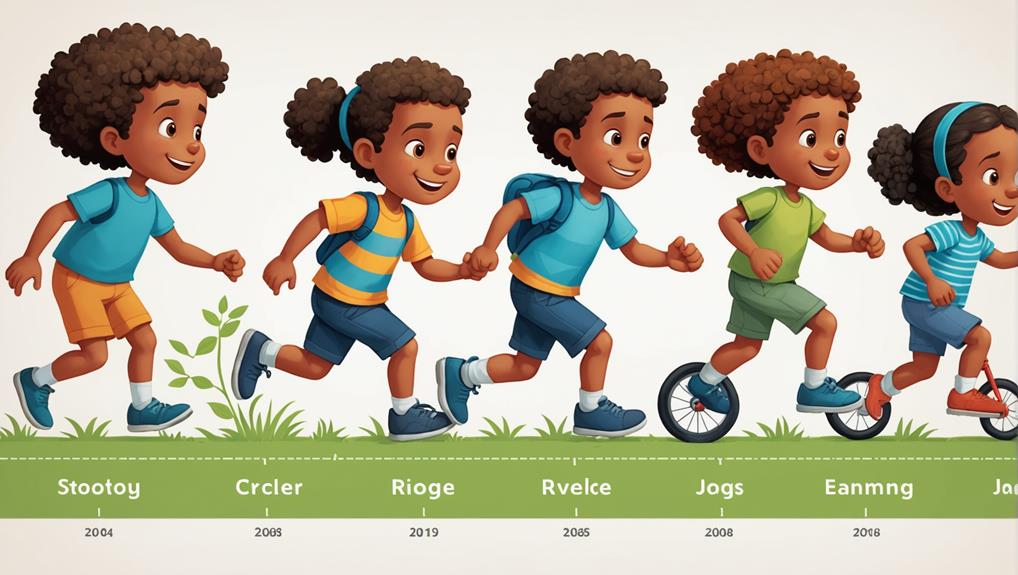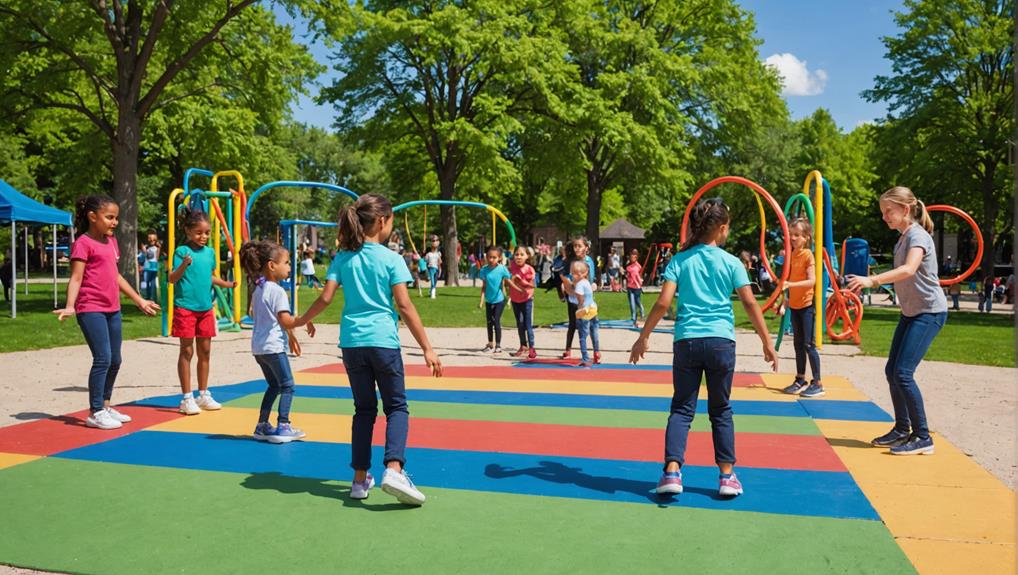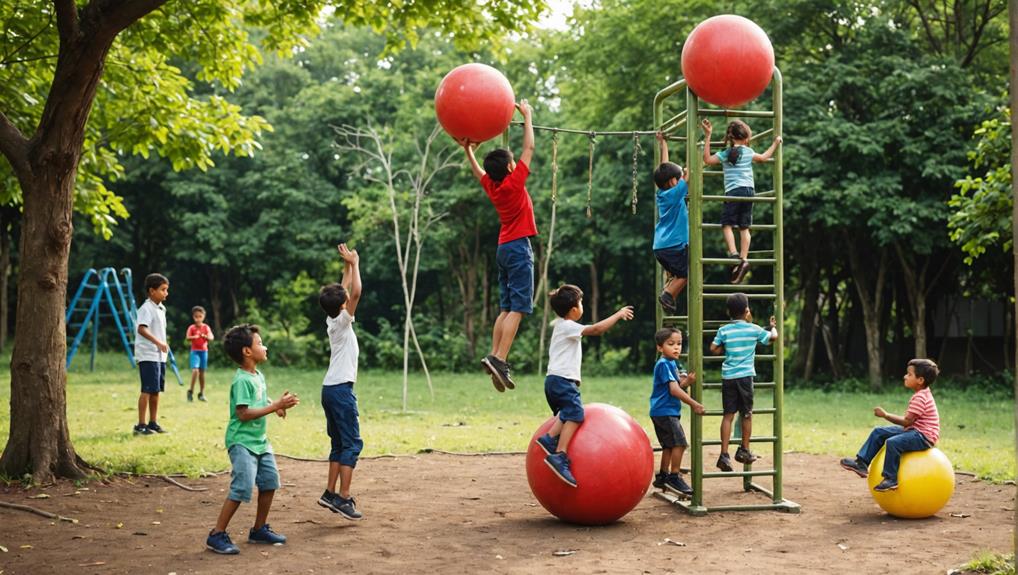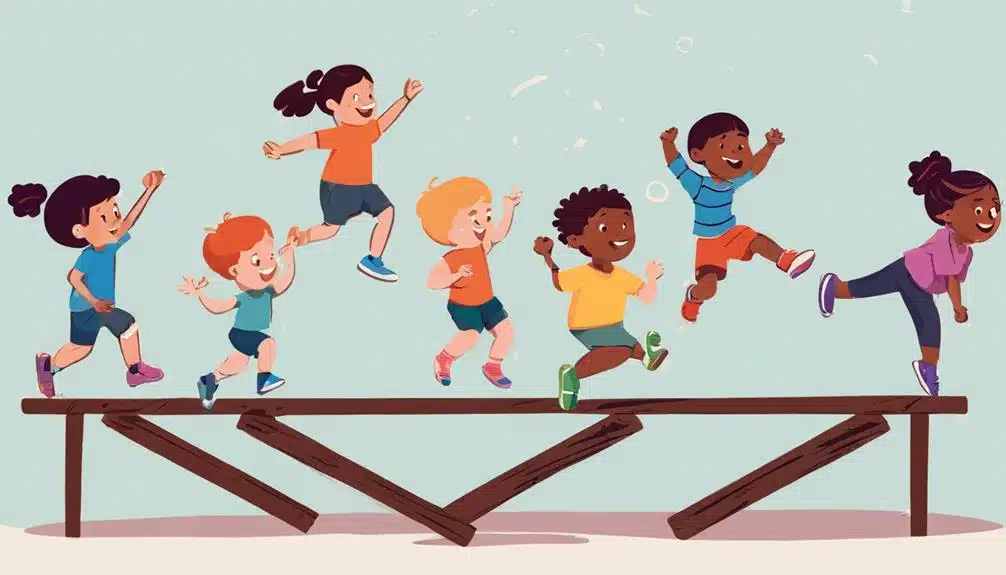The development of gross motor skills in children is a crucial aspect of their complete growth and well-being. These skills, involving the larger muscles in the arms, legs, and torso, are fundamental to everyday tasks such as walking, running, and jumping. Our detailed guide offers insights into the timeline of motor skills evolution, strategies for detecting delays, and a variety of creative, engaging activities designed to boost these essential skills. With a focus on outdoor play and imaginative tools, you might find the suggestions quite fascinating. Yet, why is the emphasis on these activities so important for a child’s development?
Key Takeaways
- Engage children in outdoor activities like hiking, biking, and creative sidewalk chalk activities to enhance their strength, balance, and coordination.
- Foster a playful environment with games, obstacle courses, and martial arts that can help improve gross motor skills and physical endurance.
- Utilize creative tools like sidewalk chalk, hula hoops, and jump ropes in imaginative play to stimulate muscle development and hand-eye coordination.
- Understand key gross motor milestones and provide appropriate activities to support children’s physical development and confidence.
- If gross motor skills delays are observed, create a supportive environment and seek early intervention to help children reach their developmental goals.
Recognizing Gross Motor Skill Delays
The passage of childhood is filled with milestones, but stumbling blocks such as clumsiness, frequent tripping, and difficulties with coordination and balance could indicate gross motor skill delays. These delays can manifest as delayed milestones, like crawling and walking, which are significant markers of a child’s physical development. Such delays can also impact a child’s ability to engage in physical activities, such as trampoline bouncing or animal movements, which are essential to their growth and development.
Children with gross motor skill delays may find obstacles in performing physical activities or participating in sports. Their reluctance is often rooted in their challenges with movement and coordination, making such activities challenging. Additionally, signs such as poor posture, slouching, or imbalance may not merely be passing phases but indications of underlying gross motor skill difficulties.
Early identification of these delays is essential. Recognizing signs and symptoms is the first important step toward intervention. Empathy and understanding play a significant role in this process, as each child’s path is distinct. Intervention strategies can support the child’s development, enhancing their confidence and overall well-being. Therefore, being informed about gross motor skill delays is crucial for anyone desiring to serve and support children in this aspect of their growth journey.
Innovative Activities for Skill Enhancement
Building on the understanding of gross motor skill delays, it becomes crucial to investigate creative and engaging avenues for boosting these essential skills in children. This investigation is pivotal in their path of child development, and imaginative activities such as trampoline activities and hopscotch games can help enrich gross motor skills.
- Playground games and a mini obstacle course can enhance coordination, strength, and hand-eye skills. Martial arts’ structured movements can add an added advantage to these activities. Consider integrating sensory paths to aid with sensory processing while improving jumping, spinning, and balancing skills.
- Yoga and dance party: Simple yoga poses can assist in balance and flexibility. Hosting a dance party can help refine coordination and rhythm, making it a fun way to develop movement skills.
- Outdoor activities: Nature walks and bike riding offer valuable chances to discover different terrains, promote balance, and improve overall gross motor skills.
These activities, crafted with empathy for children’s needs, provide a thorough approach to enhancing their gross motor skills in an enjoyable and stimulating manner. The goal is to make skill improvement a playful adventure that children anticipate, contributing to their complete development.
Motor Skills Evolution: A Timeline

Charting the progression of motor abilities in children offers a captivating peek into their developmental path. The motor skills evolution begins in infancy, with milestones such as reaching for objects, rolling over, and sitting with support emerging around 4 to 6 months. This foundational stage of development paves the way for more complex movements, such as bouncing on a trampoline and animal imitation games, which can enrich balance, coordination, and strength.
As children move into early childhood, their gross motor skills continue to refine and expand. Between 9 and 15 months, the timeline of development sees toddlers crawling, standing with support, and even taking their initial tentative steps. These are significant milestones that mark a shift towards independence.
By the time children reach age 3-5, their motor skills have refined to such an extent that activities like walking, climbing, and running become almost instinctual. This phase of development is essential for the advancement of gross motor skills, which can be further reinforced through activities like obstacle courses and outdoor play.
The timeline culminates at ages 6-7, when children master intricate movements, such as riding bicycles and writing. This progression underscores the importance of nurturing gross motor skills from infancy through early childhood. Understanding this evolution enables us to support children’s developmental voyage better.
Outdoor Activities for Skill Development
Engaging in outdoor activities can significantly improve a child’s gross motor skills development. From animal imitation games to water activities, a variety of options can offer a fun and stimulating environment for children. Activities such as hiking and bike riding not only provide a fun and stimulating environment but also challenge balance, coordination, and physical strength. Likewise, creative sidewalk activities offer a platform for exercising core strength and coordination while nurturing a child’s creativity and social skills.
Hiking and Bike Riding
Exploring the great outdoors through hiking and bike riding provides children with a myriad of opportunities to improve their gross motor skills. Engaging in these activities is akin to undertaking structured play activities, promoting physical activities like running, jumping, and even throwing when children interact with the environment. These outdoor activities not only promote physical strength and endurance but also improve balance and coordination, vital elements of gross motor skills.
The uneven terrain encountered during hiking poses challenging tasks that aid in improving a child’s muscle tone and overall physical fitness. It also offers rich sensory opportunities, from feeling the ground beneath their feet to the changing temperatures and sounds of nature.
Bike riding, on the other hand, tests and hones a child’s balance and coordination while also elevating their self-esteem as they master a new skill set. The continuous pedaling action involved in bike riding helps develop strong leg muscles, an essential aspect of improving gross motor movements and boosting overall endurance.
Below are three key benefits of these activities:
- Physical Strength and Endurance: Regular engagement in these activities increases a child’s physical strength and endurance, which are crucial for their overall growth and development.
- Sensory Opportunities: These offer a wide range of sensory experiences, fostering a child’s connection with nature.
- Balance and Coordination: The challenging tasks involved in hiking and bike riding improve a child’s balance and coordination, which are essential gross motor skills.
Through nature exploration, children not only build a solid physical foundation but also nurture a lifelong relationship with the great outdoors.
Creative Sidewalk Activities
Sidewalk activities, particularly those involving chalk, offer a unique and enjoyable pathway for children to develop their gross motor skills outdoors. Not only do these activities nurture a child’s creativity and fine motor skills, but they also support core strength as children squat and balance to create their chalk masterpieces—moreover, the precision required to draw aids in fine motor control, contributing to their overall coordination.
Drawing with sidewalk chalk is not simple; it involves large arm movements that stimulate muscle development. As children concentrate on creating detailed drawings, they unknowingly improve their hand-eye coordination, a crucial factor in motor skills development. Translating the image in their minds into a tangible drawing on the sidewalk is a complex task that demands spatial awareness and precise muscle control.
Furthermore, these sidewalk chalk activities offer an opportunity for children to enhance their balance. As they maneuver around their drawings, they subconsciously practice maintaining their equilibrium. This enjoyable and imaginative outdoor activity integrates the development of gross motor skills with an engaging leisure pursuit. In conclusion, sidewalk chalk activities are an effective and satisfying method for parents and educators to promote core strength, coordination, and motor control development in children.
Creative Tools for Gross Motor Skill

While traditional exercises and activities are crucial for a child’s gross motor skill development, introducing creative tools can potentially improve this learning process. An excellent example of such a tool is sidewalk chalk, which facilitates the development of core strength, balance, and coordination through creative play. This activity not only promotes imagination and creativity but also serves as a fun and practical approach to strengthening children’s gross motor skills.
Fun Motor Skill Tools
Three quintessential tools for improving gross motor skills in children are sidewalk chalk, hula hoops, and jump ropes. These creative tools offer engaging and entertaining ways to boost motor skills in kids of all ages.
- Sidewalk Chalk: This simple tool can transform your driveway into a canvas for gross motor activities. Children squatting to draw boosts their core strength, balance, and coordination, making it a fun way to develop their physical abilities.
- Hula Hoops: A classic game that promotes core strength and coordination. It’s not just about waist twirling; children can also jump through hoops or use them in imaginative play, further developing their gross motor skills.
- Jump Ropes: This timeless activity fosters timing, balance, and physical strength. It can be done solo or in a group and encourages social interaction while improving motor skills.
Incorporating these fun motor skill tools into playtime can significantly improve children’s physical development. By providing these opportunities, we can help children excel in their gross motor skills in enjoyable ways. These tools not only foster physical growth but also promote creativity and social skills, making them a valuable addition to any child’s playtime.
Enhancing Skills Creatively
Engaging in imaginative play, children can use basic materials like sidewalk chalk, hula hoops, and jump ropes to enhance their gross motor skills creatively. Activities like running to draw with sidewalk chalk or jumping through hula hoops can improve gross motor skills as the child develops balance, coordination, and strength.
Please encourage your child to discover their surroundings with these enjoyable tools. The simple exercises involved, such as squatting to draw with chalk or skipping rope, promote physical activity while also stimulating the brain through repetitive movement patterns. Simultaneously, these activities foster imaginative play and social interaction, essential aspects of a child’s development.
Simply playing on the playground can be a fun way of strengthening gross motor skills. Climbing ladders, swinging, or sliding down slides requires physical strength and coordination. The challenge of maneuvering different playground equipment can motivate children to push their physical boundaries and increase their confidence.
Key Gross Motor Milestones for Preschoolers
Exploring gross motor skills, preschoolers undergo a significant development phase that sets the foundation for their physical abilities. This critical period sees the blossoming of numerous talents, from running and jumping to more complex actions like climbing, balancing on one foot, and walking heel-to-toe.
Three notable milestones mark this progression:
- Independence in Walking: Typically, around 12-18 months, preschoolers start to walk independently, paving the way for advanced gross motor skills.
- Refinement of Running, Jumping, and Climbing Skills: Throughout their preschool years, children fine-tune their running, jumping, and climbing abilities, which play an integral role in their physical development.
- Advanced Skills: By ages 4-5, children begin mastering the art of throwing and catching. Around the same time, they also start experimenting with galloping movements, adding another layer to their gross motor skillset.
These milestones underscore the dynamic nature of gross motor development in preschoolers. As they continue to grow, their physical capabilities expand, offering them new ways to interact with the world around them. Understanding these milestones can help adults better support children in their developmental adventures.
Fostering Gross Motor Skill Development

Gross motor skills influence nearly all aspects of a child’s life. These skills are foundational for activities such as walking, running, and climbing. Gross motor skills development is essential for overall physical development, instilling confidence, and fostering independence.
Engaging children in active play, structured activities, and fun exercises is necessary to develop gross motor skills effectively. These activities improve balance, build strength and endurance, and enable children to control their overall body movements. They help a child balance, coordinate, and use different muscle groups to perform a variety of tasks.
Creating a supportive, engaging environment is crucial to fostering gross motor skill development. If delays or difficulties are noticed, early intervention is vital. This could involve seeking professional guidance or adjusting the child’s environment to facilitate gross motor development better.
Conclusion
To sum up, understanding and enhancing gross motor skills in children is essential for their physical development and general well-being. By recognizing potential delays early and implementing creative, engaging activities, these skills can be strengthened effectively. While some may argue that structured lessons are more advantageous, evidence indicates that promoting active, playful environments using various tools and outdoor activities can nurture these skills more organically, thereby enhancing children’s balance, coordination, and self-assurance.


Recent Comments